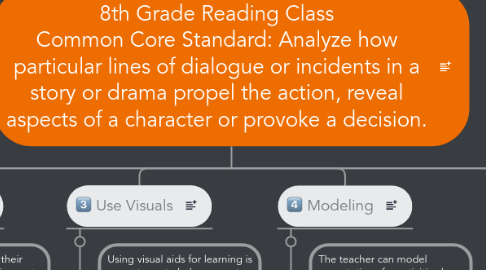8th Grade Reading Class Common Core Standard: Analyze how particular lines of dialogue or incidents in a story or drama propel the action, reveal aspects of a character or provoke a decision.
by Case Denlinger


1. Pre-Teach Vocabulary
1.1. Front loading vocabulary is a good strategy to help ensure that students won't become bored or overwhelmed when reading challenging texts. Before the chapter, the teacher can introduce new vocabulary words by showing pictures, using metaphors and letting students discuss the vocabulary in a group setting (Alber, 2011). You can also let students identify vocabulary words that they don't know while they're reading and let them discuss them as a class in the next lesson. Addressing vocabulary is important in all subjects, but especially in reading class where vocabulary words are the basic building blocks.
2. Prior Knowledge
2.1. Allowing students to tap into their prior knowledge of a subject is great way for them to connect the class activities with their real world experiences. The better they can relate to something happening in a story, the more they will understand and enjoy a text (Alber, 2011). The sooner a student can see how something relates to them personally, the sooner a deeper understanding will start to take place. In reading class, it's really important to relate a story to student's own lives so they can see how the book's themes mirror real world theme's.
3. Use Visuals
3.1. Using visual aids for learning is a great way to help connect content with student engagement. If students can actually see examples, they'll be more likely achieve objectives. If real life examples aren't available, use images and pictures (Houser, 2014). For example, in my comic strip lesson plan, I would show examples of actual comic used in newspapers for the students to look at.
4. Modeling
4.1. The teacher can model expectations for activities by doing it themselves in front of the students. This gives the students an idea of what to do and how to do it. The "I Do, We do, They Do, You Do" strategy that we learned in Module 4 is great way to model assignments to your students by showing them the desired outcome before they start the project.
5. Working Together
5.1. Allowing students to work in small groups or with partners is a great way to scaffold lesson plans. Before working independently, student may find it easier to understand content by working with a peer so they can learn from each other.
6. Reading Together
6.1. During reading class, it's especially important to read with your students instead of having them always read alone. Reading together often leads to group discussion and active engagement. During this time, students can ask questions that they have about the story and it allows other students to answer these questions instead of the teacher. This also models good reading hobbits for the students (Houser, 2014). Reading together also allows the teachers to pause and check for understanding before moving on (Alber, 2011). For this objective, I can have students use a highlighter to highlight key dialogue they hear during this activity The first thing they need to be able to do for this standard is identify key dialogue. From there, they can begin to analyze its implications to the story.
6.1.1. Sources
